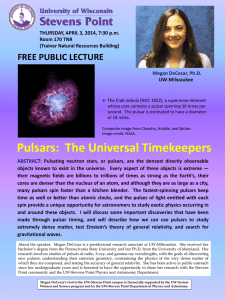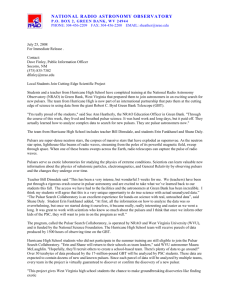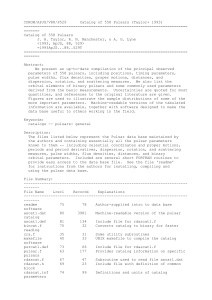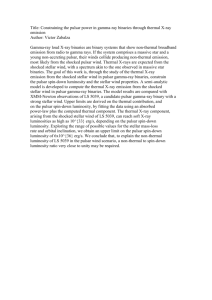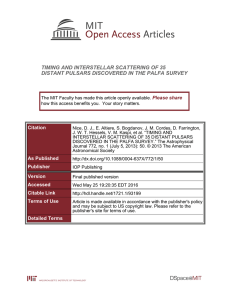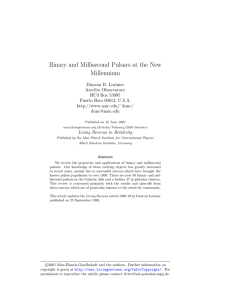Pulsars
advertisement
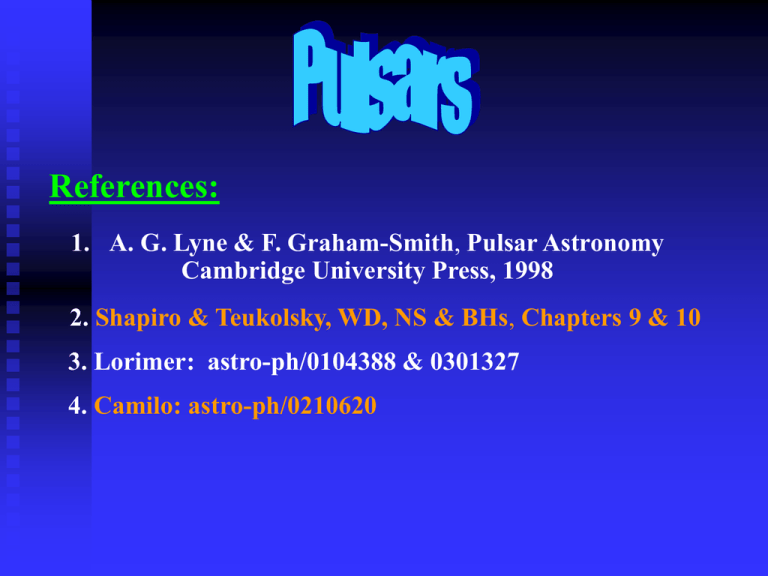
References: 1. A. G. Lyne & F. Graham-Smith, Pulsar Astronomy Cambridge University Press, 1998 2. Shapiro & Teukolsky, WD, NS & BHs, Chapters 9 & 10 3. Lorimer: astro-ph/0104388 & 0301327 4. Camilo: astro-ph/0210620 1967: Hewish, Bell et al. discover radio pulsars. 1974: Nobel prize to Ryle (aperture synthesis) and Hewish (pulsars). 1968: Gold proposes rotating NS model for Pulsars Why neutron stars? • Pulsation timescale for WD is: (R3/GM)1/2/2pi ~ 1 s (The period of the closest orbit is similar; moreover, these timescales decrease with time - not increase as for pulsars). • The break-up rotation period for WDs is also ~ 1 s. • Not possible to get highly stable periodic signal from BHs. • The break-up rotation period, pulsation or dynamical time for a NS is ~ milli-sec; rotation can explain the observed period range and stability. Observational Properties of Pulsars • Period range: 1.5 milli-sec --- 8 sec. • Luminosity in the radio band ~ 1025 -- 1028 erg/s • Radio luminosity distribution: N(L) dL L-1 dL (This holds over 3-decades in L. The total number of active pulsars for L> 1 mJy kpc2 is ~ 150,000; pulsars we observe are more luminous than average for the Galaxy by a factor 10-100, the Typical flux is of order 100 mJy). • The spectrum index is ~ 1.5 I.e. f --1.5 for < 1 GHz. Period Derivative Some elementary considerations: Collapse of a star -- conserving angular momentum & magnetic flux -- to NS gives rise to msec P and B~1012 G • M R2 = M R2n n Pn = P (Rn/R)2 Pn ~ 1 ms (P ~ 1 month; R/ Rn ~ 1010) • R2 B = R2n Bn Bn = B (R/Rn)2 Bn ~ 1012 Gauss Pulsar Distance Determination 1. Parallax 2. Neutral H absorption at 21 cm: The Doppler shift of the 21cm absorption line together with the dynamical model of the Galaxy can be used to identify the location of the H-cloud and determine the distance to the pulsar. 3. Dispersion measure: (pulses at different arrive at different times) 2 = 2p + k2 c2 2p = 4 ne e 2 /me = 3x109 ne (rad/s)2 DM = dl n e Pulse Dispersion (Lyne & Graham-Smith in “Pulsar Astronomy) Lyne & Graham-Smith in “Pulsar Astronomy) Magnetic dipole Radiation formula Magnetic dipole rad. energy loss rate: dE/dt = -2(d 2 m/dt 2)2 /3c3 ; m = Bn R3n/2 m: the magnetic moment of the NS Or dE/dt = - Bn2 R6n n4 sin2 /6c3 dE/dt ~ 1035 erg/s for Bn ~ 1012 & P=0.1s Solution of this equation and breaking index E = I n2 dn/dt = - K na; a: breaking index For the dipole model a=3. Observations give a between 1.4 & 2.8 B determined from the dipole radiation formula (Lyne & Graham-Smith in “Pulsar Astronomy”; Cambridge U. press 1998) Pulsar magnetosphere • NS surrounding is completely dominated by Electro-dynamics. The pressure scale height on a NS for 108 K plasma is ~ 100 cm. Thus, the number density 100 m above the NS surface < 10-5/cc (provided that EM forces are unimportant). • Goldreich-Julian model (aligned rotator) • Charge density (pulled from the surface of NS) • Electric potential drop along open B-field lines • Poynting flux at the light-cylinder & NS slowdown rate Summary of Axisymmetric NS magnetosphere results E r (R) FE FG BR 2C 4x10 B12 7 10 B12 Statvolt cm-1 7 n 10 B12 10 cm-3 (Goldreich-Julian density) Poyinting flux: dE BR2 R 64 dt 8 c 4 (same as the dipole radiation formula) Summary of last lecture Crab nebula The nebula is powered by poynting outflow from the pulsar. (Plerion) e-s with energy > 1014 ev are accelerated by the electric field in the polar region; these e-s are needed for emission at 10 kev. Rotational energy of the NS Is the energy source for The Luminosity ~ 1038 erg/s (mostly x-ray & gamma) Synchrotron radiation Blue: x-ray Red: optic Green:rad Pulsar radio-emission must be coherent radiation • Pulsar radio luminosity, assuming conical geometry, is found to be in the range of 1025 -- 1028 erg/s. • The source area ~ (c t)2 ; where t is the pulse width (t ~ a few milli-sec) This implies The brightness temperature Tb ~ 1023 -- 1026 K! This is clearly not possible --- as it will lead to enormous luminosity. ms pulsars Milli-sec pulsars have low magnetic field (Lyne & Graham-Smith in “Pulsar Astronomy”; Cambridge U. press 1998) Spin-up of a NS in a binary system (Spherical accretion) Ram pressure of in-falling gas balances the magnetic pressure: Ýv Ý M M 2 v 2 4 r 4 r 2 Or Req where 1 (8G )1/ 7 6 2GM B (r) B R* r 8 8 r 2 2 * 12 27 37 27 8 47 7 Ý Ý cm B* R* M M 1.25x10 B12R6 m m 4 7 12 7 17 M mMo, MÝ 1.39x1018 m mÝ g s-1 (For disk accretion the viscous torque in the disk is equated to the magnetic torque in from the star; Req turns out to have the same form as above and the numerical coefficient is also similar.) Spin-up Equilibrium eq GM 3 R eq or Peq 2 eq 6 7 18 7 87 37 Ý 2.2 B9 R6 m m ms Propeller effect: If the period of the NS is smaller than Peq then matter is not accreted onto the NS. Click here to find details. Spin-up Line: The fastest spin rate for a NS corresponds to dm/dt =1. Substitute for B in terms of P & dP/dt in the above equation 18 37 87 7 Ý Pmin P15 0.8 R6 m 4 7 2 3 Ý B All binary radio pulsars lie below the spin-up line. Many single ms pulsars are seen, and they too lie below this line. It is believed that these too were spun-up in a binary system, and either the companion was evaporated by the pulsar or was lost in a binary collision. Spin-up Time A crude model describing the time evolution of NS spin is: d Ý( eq )Req2 I M dt or 2 MÝR eq t /I (t) eq 1 e The spin-up time: tspinup I 2 MÝR eq 87 9 24 7 6 17 37 Ý I45 yr 3.6x10 B R m m 6 Anomalous x-ray pulsars (AXPs) References: 1. 2. 3. 4. 5. Mereghetti et al., 2002, Astro-ph/0205122 Thompson, astro-ph/0010016 & 0110679 Pavlov et al., 2001, Astro-ph/0112322 Hurley, 1999, astro-ph/9912061 Gaensler, 2002, astro-ph/0212086 Summary of observational properties Five confirmed cases of AXPs as of 2004. Pulsation period: 5--12 s. x-ray luminosity: Lx ~ 1034 --1036 erg s-1. PÝmeasured gives P/PÝ ~ 103.5 -- 105.5 yr. Black-body kT < 0.5 kev + steep power-law spectrum No radio emission. No binarycompanion detected. 2 or 3 are associated with supernovae remnants. Energy source for AXPs? • P ~ 6s & ~ 1 s-1 EKE ~ 5x1044 erg (insufficient to explain Lx). (So unlike normal pulsars the energy source is NOT rotational) • Accretion is also ruled out since AXPs are not in binary systems. The most likely source is the dissipation of magnetic field P & dP/dt give B ~ 1014 -- 1015 Gauss. (click here for the P-B diagram) Energy in B-field ~ 1045 -- 1047 erg This is sufficient to explain Lx as resulting from a steady decay of B-field inside NS! Soft gamma-ray repeaters References: • • • Thompson, astro-ph/0010016 & 0110679 Kaspi, V., 2004, Astro-ph/0402175 Woods, P.M., 2003, astro-ph/0304372 Summary of observational properties • 4-6 objects are known. (Rare events) • All but one SGRs are in the Galactic plane (one in LMC). (bursts are associated with young stellar population) • The one in the LMC is in a supernova remnant. (associated with NS or a BH) • Three SGRs have been seen to pulse with period in the range 5--8 s. Two of these 3 have pulsations in x-rays during quiescence as well & are spinning down. (almost certainly SGRs are associated with NS) • Soft -ray and x-ray bursts with typical energy ~ 1041 erg. Rise time ~ 10 ms & duration ~ 100 ms. Occasionally energy Greater than 4x1044 erg. But no binary companion detected. (Not accretion powered! KE of NS rotation too little as well) 15 Gauss. Ý In 2 cases the measured P and gives B ~10 P • (The energy in magnetic field ~ 1047 erg; sufficient to power these bursts). could be inactive for years and • Bursts repeat episodically; then hundreds of bursts could appear in a week. • Generally thermal Bremsstrahlung spectrum with kT ~ 20 - 50 kev. Taken from: Exploring the x-ray Universe -- Charles & Seward, 1995, Cambridge U. Press Click here to go back Manchester, 2000, astro-ph/0009405 Click to return
